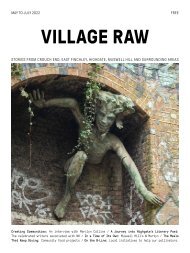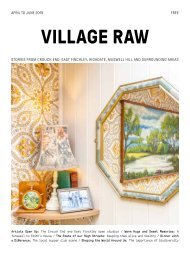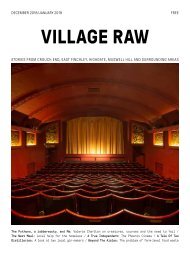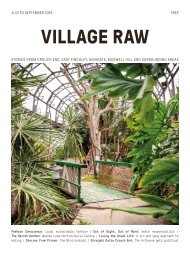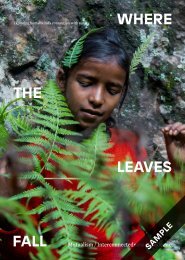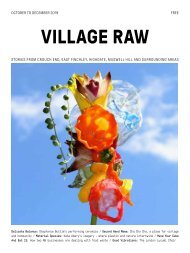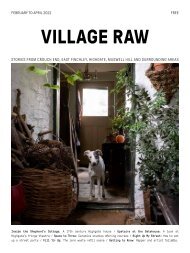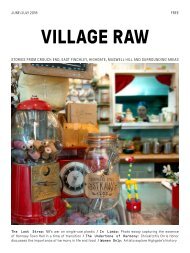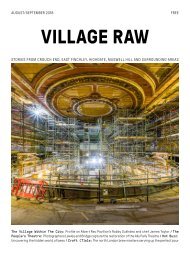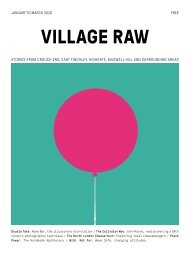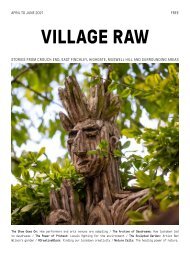Village Raw - ISSUE 3
Village Raw is a magazine that explores cultural stories from Crouch End, East Finchley, Highgate, Muswell Hill and the surrounding areas. The magazine is created by the community, for the community. If you like this issue you can support the project through a subscription or donation. See the links below. The third issue of Village Raw magazine includes: ART TRAILS AND TALES - Ben Wilson’s art – a chewing gum diary of our times. ART AND SOUL- The restorative work of Studio 306 Collective. MADE BY DESIGN - Two makers explore different approaches to manufacturing. OMVED - A picture profile of Highgate’s OmVed Gardens. EVOLUTION AND SOURDOUGH - Michelle Eshkeri discusses business, baking, and balance. BOOGALOO RADIO - The chemistry of love and chaos. THE WOODS - Muswell Hill musician Johnny McFazdean’s musical textures. GEEJAY - The Stroud Green duo discuss their journey into music. LIVING LOW WASTE - Emma Ross begins a new column exploring sustainable living. VILLAGE ESSAY - Saying hello by Lulu Socratous. AND MORE… Village Raw is created by the community, for the community. If you like this issue you can support the project through a subscription or donation. See the links below.
Village Raw is a magazine that explores cultural stories from Crouch End, East Finchley, Highgate, Muswell Hill and the surrounding areas. The magazine is created by the community, for the community. If you like this issue you can support the project through a subscription or donation. See the links below. The third issue of Village Raw magazine includes:
ART TRAILS AND TALES - Ben Wilson’s art – a chewing gum diary of our times.
ART AND SOUL- The restorative work of Studio 306 Collective.
MADE BY DESIGN - Two makers explore different approaches to manufacturing.
OMVED - A picture profile of Highgate’s OmVed Gardens.
EVOLUTION AND SOURDOUGH - Michelle Eshkeri discusses business, baking, and balance.
BOOGALOO RADIO - The chemistry of love and chaos.
THE WOODS - Muswell Hill musician Johnny McFazdean’s musical textures.
GEEJAY - The Stroud Green duo discuss their journey into music.
LIVING LOW WASTE - Emma Ross begins a new column exploring sustainable living.
VILLAGE ESSAY - Saying hello by Lulu Socratous.
AND MORE…
Village Raw is created by the community, for the community. If you like this issue you can support the project through a subscription or donation. See the links below.
Create successful ePaper yourself
Turn your PDF publications into a flip-book with our unique Google optimized e-Paper software.
VILLAGE RAW<br />
RAW MATERIAL<br />
MADE BY<br />
DESIGN<br />
One looks to the future,<br />
while the other harks<br />
back to the past.<br />
Two talented designers,<br />
working out of their<br />
homes, have very<br />
different approaches<br />
to manufacturing<br />
their products.<br />
Words by Carla Parks.<br />
On the face of it, Huw Williams and Adriana<br />
Conde Betts don’t have much in common.<br />
One is from Oxford, the other from Brazil.<br />
One studied industrial design, while the<br />
other trained as an architect. One works<br />
with plastic, the other with leather. One<br />
uses modern technology, the other uses<br />
a craft handed down through generations.<br />
But both love design and have recently<br />
started selling to consumers who<br />
appreciate their attention to detail.<br />
In just one year, Huw quit his steady<br />
job, set up his own shop and started selling<br />
unique objects he’s made with a 3D<br />
printer bought for only about £110. His designs<br />
include pots, planters, pens, clocks<br />
and ring holders - all made in his studio<br />
in Bounds Green, which is also his home.<br />
“I get a lot of love from the local area,”<br />
says Huw, who started selling his wares at<br />
Alexandra Palace Farmers’ Market in January.<br />
“It was cold,” he laughs. Since then,<br />
the 25-year-old has been experimenting<br />
and adding to his collection for his shop<br />
Studio Nilli. He’s had customers from as far<br />
away as Trinidad and Tobago and Australia.<br />
A current favourite piece is a wooden-legged<br />
planter which takes inspiration from<br />
the mid-century modern style.<br />
Huw, who studied industrial design at<br />
Brunel, has always liked making things. As<br />
a child he used to make enormous paper<br />
“It’s not so much a science as<br />
it is an art form, because you<br />
do have to finesse something<br />
out of this code.”<br />
ented,” she explains. Some of these details<br />
include adding a tag to the shoes<br />
with the name of the person who made<br />
them. Adriana wants the shoes to feel<br />
fun, so she uses bright colours for the<br />
lining which contrast with the high-quality<br />
leather.<br />
To make each shoe, Adriana employs<br />
traditional techniques. Using “lasts”, a<br />
mechanical form that has the shape of<br />
the human foot, she tests out the integrity<br />
of her designs. She sometimes even<br />
covers her daughter’s old shoes to see<br />
how a new design might look. “I want to<br />
PHOTOS BY DAVID REEVE (STUDIO NILLI, TOP LEFT AND RIGHT) AND KATE KUZMINOVA (YAYA LALA, TOP RIGHT AND BOTTOM LEFT).<br />
Opposite page: Huw<br />
Williams working on<br />
designs while the<br />
3D printer builds<br />
a pot layer by layer.<br />
This page: Adriana<br />
Conde Betts designing<br />
a shoe in London,<br />
while they are<br />
handmade in Portugal.<br />
keep the process quite organic,” explains<br />
the former architect, who lives in Muswell<br />
Hill. When she’s happy with the design,<br />
she sends it to the manufacturer to make<br />
a prototype.<br />
Prototypes are a common feature of<br />
3D printing. Huw’s printer was assembled<br />
and modified through a process called<br />
RepRap - which stands for replicating rapid<br />
prototyper. Essentially, it’s a machine<br />
that prints a significant number of its<br />
own parts automatically, thus replicating<br />
itself. The first of its type appeared at the<br />
University of Bath in 2005 and many copies<br />
have been made since because the<br />
designs of the project are open source,<br />
available to anyone who has an interest.<br />
To make an object, Huw designs a 3D<br />
model on a computer using a computer-aided<br />
design (CAD) package; he takes<br />
it into another programme which slices it<br />
into layers and writes the code; and then<br />
he sends it to print. There is some tweaking<br />
to be done too, and the products are<br />
finished by hand. “It’s not so much a science<br />
as it is an art form, because you do<br />
have to finesse something out of this<br />
code,” he explains. A large planter will<br />
take just over an hour and half to make.<br />
Adriana’s shoes are intricate and labour-intensive,<br />
but that’s part of her<br />
philosophy – to make them feel personal,<br />
crafted with love and attention by<br />
a human being. With their vintage look,<br />
she says they are reminiscent of an era<br />
more focused on quality and time. “I want<br />
the consumer to understand that someone<br />
made these shoes from nothing into<br />
something and then it became theirs.”<br />
She believes we’ve become disconnected<br />
from the process of how things are<br />
made and then sold to us. Too much is<br />
mass-produced, argues the Brazilian.<br />
“I want the consumer to<br />
understand that someone made<br />
these shoes from nothing<br />
into something and then it<br />
became yours.”<br />
Huw is also focused on producing small<br />
quantities, but his method is a quick way<br />
of manufacturing one-offs. The products<br />
are printed in bioplastic, meaning that the<br />
material is made from renewable biomass<br />
such as corn starch and sugarcane. It’s biodegradable<br />
if taken to an industrial composter.<br />
In an effort not to produce waste,<br />
he’ll make earrings and cufflinks with<br />
some of the plastic left over.<br />
Even though Huw’s products are<br />
technically made by a machine, he points<br />
out that it’s still him behind every design.<br />
“I use digital design and manufacturing<br />
aeroplanes out of newspaper. Inspiration<br />
comes from everywhere, he says, and<br />
he loves sketching his ideas and seeing<br />
them develop.<br />
It’s the same for Adriana, who designs<br />
children’s shoes which are then made by<br />
skilled artisans in Portugal. One of her<br />
shoe designs, Trinity, was inspired by a<br />
visit to a church called All Saints Margaret<br />
Street. Like Huw, she runs her business<br />
Yaya Lala from her home. Always a<br />
creative person, Adriana spotted a gap in<br />
the market after having her daughter in<br />
2009. “Our focus is on being detail-oritools<br />
to help produce my work, but I think<br />
the connotations that go with ‘handmade’<br />
still apply. Great skill, time and<br />
love have gone into making a product,<br />
and that’s what a lot of people appreciate<br />
about something handmade. There is<br />
always a story, someone’s idea, process<br />
and final result.”•<br />
Huw will be at the RHS Urban Garden Show,<br />
26-28 October. He sells via Etsy at: www.studionilli.com;<br />
and Kettle’s Yard at: www.kettlesyard.co.uk<br />
Adriana’s shoes are available at: www.yayalala.com<br />
14 15



